We've found plenty to do 'In a Town like the Isa', arriving around lunchtime after travelling the 190kms from Camooweal. When we watched a DVD on the development of Mount Isa late this afternoon, it seemed very fitting that it concluded with John Williamson singing 'Back at the Isa'. The words of the song now have a whole new meaning for us!
The main tourist attraction in the town is the 'Hard Times Mining Tour'. We did that yesterday morning and it was a good intro to the history of the town. Bill our tour guide was a miner for 34 years and has been retired for 17 years. He does the tours for 7 months of the year and becomes a 'grey nomad' for the other 5 months! So he seems to have it worked out pretty well in his retirement. Still making a contribution to the community as well as doing something he loves. They obviously go travelling during the wet season. Not that it has been wet here for sometime!. They are in drought and they have not had a wet season for the last two years. Many trees have died and all the verges are dry. Residents are only able to water between 8 and 10 pm, every second evening.
The city of Mount Isa is very much about the mine and mining. The population is around 22,000 and they claim to have over 50 different nationalities living in the town. It has a very itinerant population, but it is also said "That people come here for the BIG money, they only intend to stay for a couple of years and stay longer". In fact that is what the beautician I went to on Tuesday afternoon said had happened to her and her partner (it was time to tidy up the caravan eyebrows and legs). He came up here first. It was too difficult to get ahead living in Sydney. Then she followed. They planned to stay 2 years and have now been in 'The Isa' seven years and have bought themselves a home. They are getting married in October.
These days miners work 12 hour shifts from 6 until 6. Four days on and four days off and the least amount they will earn is $190,000 per year. The 'Hard Times Mining Tour' has been operating since about 2006. Prior to that a tour was available at the 'Mount Isa Mines' site. Then a lady fell and broke her leg and sued the company and that was the end of the tours!
Through Local Government and State Government grants and community support, $12 million was raised to create the mine we went down. It took 6 years for their dream to be realised. The mine is only 22 metres deep and there are about 500 metres of tunnels. They have been very fortunate to have acquired various pieces of mining machinery. We saw a number of pieces of machinery that has been used for greater than a 50 year period and each was demonstrated.
Today the main underground mine in Mount Isa has around 19 levels, is 2 kilometres underground and there are 1,000 kms of tunnels. Back in the 90's vehicles never came to the top. Once vehicles were taken down there, they stayed down there. Nowadays four wheel drive vehicles are driving in and out of the mine constantly. The heavy machinery used for the 'Mucking Out' of the blasted rock is never brought to the surface. It is too expensive to bring it out again. Once the machines are no longer required, they salvage parts and then tip them into one of the dug out pits or stopes. Bill explained the process to us and this bit from Wikipedia puts it into words better than I can:
Where large bulk ore bodies are to be mined at great depth, or where leaving pillars of ore is uneconomical, the open stope is filled with backfill, which can be a cement and rock mixture, a cement and sand mixture or a cement and tailings mixture. This method is popular as the refilled stopes provide support for the adjacent stopes, allowing total extraction of economic
resources. Bill said "They use cement and tailings mixture to fill the stopes".
The story of the 'Mount Isa Mine' which is rich in silver-lead, zinc and copper is as follows: In 1923 a prospector John Campbell Miles discovered lead ore while travelling through the region. Convinced of the importance of his discovery, John quickly pegged out a lease and he named it 'Mount Isa'. Word spread quickly and by the end of 1923, 118 leases had been pegged. By January 1924 'Mount Isa Mines Ltd' was established. In the early years 'Mount Isa Mines Ltd' faced hardship in developing the mine and transporting the ore to the port of Townsville. Before the railway line was constructed, the ore had to be transported 135kms to Cloncurry by camel and cart. The first train did not leave Mount Isa until 1929. The rail line went on to become the State's most profitable line and provided the State Government with the capital to revitalise other rail lines throughout Queensland.
It was not until 1937, 13 years after the mine commenced operation, that the company enjoyed its first operating profit. In 1943 the mine halted lead mining and started mining for copper to meet the Government's WW2 needs. In 1946 lead was being mined again and by 1953 both were being equally mined. By 1955 'Mount Isa Mines Ltd' was the largest mining company in Australia. It had weathered technical and financial difficulties, and industrial unrest, to become Australia's largest single creator of export income.
In 1964 the mine temporarily closed the copper smelter, due to an industrial dispute against the mine after a disagreement on how the wealth of the productive field should be shared. The Queensland Government declared a State of Emergency and the dispute was settled in April 1965. From that time employees have been on wages, rather than the amount of rock that had been cleared on each shift. Ever since 1924 there has been two blasts in the mine each day, 7 days a week. In the early years the blasts were at 'crib time'. Today the blasts are at 8 at night and 8 in the morning. Bill told us how everyone must be in the 'crib room' and accounted for before each blast.
The Museum and Theatre at the 'Outback Isa Information Centre' provided a really good picture of the growth of the town and its history. The 'Outback Isa' also has a 'Riversleigh World Heritage Fossil' display. Riversleigh and Naracoorte Fossil areas were both listed on the World Heritage Register in 1994. The 'Riversleigh World Heritage Fossil Fields' are on the Riversleigh Cattle Station 200 kms north of Mount Isa and 200 south of the Gulf of Carpentaria. It is near the Gregory River. All very fascinating, viewing these prehistoric bones preserved in the rock. A special acid is used to dissolve the rock, so the bones can be removed. ' Outback Isa' did have funding for tours to be conducted while the scientist was removing the bones from the rock, but unfortunately that has ceased, so nothing was happening in the laboratory.
We also visited the 'Underground Hospital' and the 'Beth Anderson Museum'. It is a really interesting story about how this 'Underground Hospital' came to be, and certainly well worth the visit. It is said to be "The only one that has been found and is open to the public in the world". It was built in 1942, after Darwin was bombed. It was felt that the Japanese would soon realise where the copper and lead was being mined and Mount Isa could be a potential target. The Hospital Board decided an underground hospital was needed and when the hospital medical superintendent put the proposition to the men, there was no shortage of volunteers. The 'Mount Isa Mines' was quick to supply the necessary materials.
The 'Beth Anderson Museum' is a display of hospital equipment, beds and instruments. There was so much stuff there. It is all out on the verandah as well. I asked the lady if they covered it up and whether they moved it somewhere for the wet season, as they close from September until March. She said "No it stays there. We've got nowhere else to put it! We wash the linen before we open up again. We've had that husband and wife separated in those beds out there on the verandah's, for the last 12 years"! I laughed and went back and took some more photos. One was on the back verandah and one out the front. Poor couple! I'm sure I can journal a good story under those two photos.
The 'Underground Hospital' stands as a monument to the ingenuity, tenacity and determination of the people of Mount Isa. It was never used, apart from a couple of times that patients were moved in there when the air-raid siren went off. After the war, stones were pushed into the openings and it remained unchanged until someone found the ground subsiding in 1977. It was in such a bad way that it was closed up and nothing happened for another 20 years. In 1997, some miners offered to restore it on their days off. It took 4 1/2 years and it was opened to the public in 2001. Nearly everything is still as it was in 1942. Even down to the linen and china in the cupboard. Chloroform was even there in a couple of bottles! The liquid in the bottom of the bottle had gone all furry!
'Lake Moondarra' is located 16kms from Mount Isa and is the cities main water supply. In the 1960's it even had a beach and a Surf Life Saving Club. The flag of the Surf Club is now in the Museum. The lake was born out of necessity in the 1950's when there was great demand for a water supply for the ever expanding mine and city. 'Mount Isa Mines Ltd' made the decision to construct what was at that time, Australia's largest privately funded water scheme. In December 1956, when the wall was only half finished, seasonal rains sent a huge flood through the wall. It took until 1957 to finish the 26.5 metre concrete-faced wall, at a cost of $2.4 million.
The last piece of history we visited in Mount Isa was the 'Iconic Town Clock', which is in the centre of one of the main streets in the CBD area. It has become a Memorial and is the last resting place for the ashes of 'John Campbell Miles'. His discovery of the ore was the birth of Mt Isa. He sold his share in the mine for 50,000 pounds which didn't last long as he continued to search for gold. He visited Mt Isa occasionally, never married and died in 1965. His ashes were interred beneath the Memorial Clock in 1968.
Mount Isa has been a really interesting city to visit. The fact that 'Mount Isa Mines Ltd' is right on the edge of the city is really different and not what you expect to see. You can drive very close to the mine. Much of the towns early history revolves around the miners living on the mine side of the river in far better conditions than the town people who lived on the other side of the Leichhardt River. The railway line is now seen to be the line dividing the mine from the city. One of the early mine managers, an American known as JK, has been accredited with much of the success of the mine, largely due to the changes he instigated. He also built an impressive house that is still an icon in the city today. Many dignitories have stayed in the house. George Fisher took over from him in the 1950's and was responsible for improved housing for miners and the growth of the town.
For us it has definitely been...........
Big galvanised roofs and monster pipes black
Pink and white clouds from a chimney stack
Red dust and hawks in the wind outback
And here WE are at the Isa..........
The main tourist attraction in the town is the 'Hard Times Mining Tour'. We did that yesterday morning and it was a good intro to the history of the town. Bill our tour guide was a miner for 34 years and has been retired for 17 years. He does the tours for 7 months of the year and becomes a 'grey nomad' for the other 5 months! So he seems to have it worked out pretty well in his retirement. Still making a contribution to the community as well as doing something he loves. They obviously go travelling during the wet season. Not that it has been wet here for sometime!. They are in drought and they have not had a wet season for the last two years. Many trees have died and all the verges are dry. Residents are only able to water between 8 and 10 pm, every second evening.
The city of Mount Isa is very much about the mine and mining. The population is around 22,000 and they claim to have over 50 different nationalities living in the town. It has a very itinerant population, but it is also said "That people come here for the BIG money, they only intend to stay for a couple of years and stay longer". In fact that is what the beautician I went to on Tuesday afternoon said had happened to her and her partner (it was time to tidy up the caravan eyebrows and legs). He came up here first. It was too difficult to get ahead living in Sydney. Then she followed. They planned to stay 2 years and have now been in 'The Isa' seven years and have bought themselves a home. They are getting married in October.
These days miners work 12 hour shifts from 6 until 6. Four days on and four days off and the least amount they will earn is $190,000 per year. The 'Hard Times Mining Tour' has been operating since about 2006. Prior to that a tour was available at the 'Mount Isa Mines' site. Then a lady fell and broke her leg and sued the company and that was the end of the tours!
Through Local Government and State Government grants and community support, $12 million was raised to create the mine we went down. It took 6 years for their dream to be realised. The mine is only 22 metres deep and there are about 500 metres of tunnels. They have been very fortunate to have acquired various pieces of mining machinery. We saw a number of pieces of machinery that has been used for greater than a 50 year period and each was demonstrated.
Today the main underground mine in Mount Isa has around 19 levels, is 2 kilometres underground and there are 1,000 kms of tunnels. Back in the 90's vehicles never came to the top. Once vehicles were taken down there, they stayed down there. Nowadays four wheel drive vehicles are driving in and out of the mine constantly. The heavy machinery used for the 'Mucking Out' of the blasted rock is never brought to the surface. It is too expensive to bring it out again. Once the machines are no longer required, they salvage parts and then tip them into one of the dug out pits or stopes. Bill explained the process to us and this bit from Wikipedia puts it into words better than I can:
Where large bulk ore bodies are to be mined at great depth, or where leaving pillars of ore is uneconomical, the open stope is filled with backfill, which can be a cement and rock mixture, a cement and sand mixture or a cement and tailings mixture. This method is popular as the refilled stopes provide support for the adjacent stopes, allowing total extraction of economic
resources. Bill said "They use cement and tailings mixture to fill the stopes".
The story of the 'Mount Isa Mine' which is rich in silver-lead, zinc and copper is as follows: In 1923 a prospector John Campbell Miles discovered lead ore while travelling through the region. Convinced of the importance of his discovery, John quickly pegged out a lease and he named it 'Mount Isa'. Word spread quickly and by the end of 1923, 118 leases had been pegged. By January 1924 'Mount Isa Mines Ltd' was established. In the early years 'Mount Isa Mines Ltd' faced hardship in developing the mine and transporting the ore to the port of Townsville. Before the railway line was constructed, the ore had to be transported 135kms to Cloncurry by camel and cart. The first train did not leave Mount Isa until 1929. The rail line went on to become the State's most profitable line and provided the State Government with the capital to revitalise other rail lines throughout Queensland.
It was not until 1937, 13 years after the mine commenced operation, that the company enjoyed its first operating profit. In 1943 the mine halted lead mining and started mining for copper to meet the Government's WW2 needs. In 1946 lead was being mined again and by 1953 both were being equally mined. By 1955 'Mount Isa Mines Ltd' was the largest mining company in Australia. It had weathered technical and financial difficulties, and industrial unrest, to become Australia's largest single creator of export income.
In 1964 the mine temporarily closed the copper smelter, due to an industrial dispute against the mine after a disagreement on how the wealth of the productive field should be shared. The Queensland Government declared a State of Emergency and the dispute was settled in April 1965. From that time employees have been on wages, rather than the amount of rock that had been cleared on each shift. Ever since 1924 there has been two blasts in the mine each day, 7 days a week. In the early years the blasts were at 'crib time'. Today the blasts are at 8 at night and 8 in the morning. Bill told us how everyone must be in the 'crib room' and accounted for before each blast.
The Museum and Theatre at the 'Outback Isa Information Centre' provided a really good picture of the growth of the town and its history. The 'Outback Isa' also has a 'Riversleigh World Heritage Fossil' display. Riversleigh and Naracoorte Fossil areas were both listed on the World Heritage Register in 1994. The 'Riversleigh World Heritage Fossil Fields' are on the Riversleigh Cattle Station 200 kms north of Mount Isa and 200 south of the Gulf of Carpentaria. It is near the Gregory River. All very fascinating, viewing these prehistoric bones preserved in the rock. A special acid is used to dissolve the rock, so the bones can be removed. ' Outback Isa' did have funding for tours to be conducted while the scientist was removing the bones from the rock, but unfortunately that has ceased, so nothing was happening in the laboratory.
We also visited the 'Underground Hospital' and the 'Beth Anderson Museum'. It is a really interesting story about how this 'Underground Hospital' came to be, and certainly well worth the visit. It is said to be "The only one that has been found and is open to the public in the world". It was built in 1942, after Darwin was bombed. It was felt that the Japanese would soon realise where the copper and lead was being mined and Mount Isa could be a potential target. The Hospital Board decided an underground hospital was needed and when the hospital medical superintendent put the proposition to the men, there was no shortage of volunteers. The 'Mount Isa Mines' was quick to supply the necessary materials.
The 'Beth Anderson Museum' is a display of hospital equipment, beds and instruments. There was so much stuff there. It is all out on the verandah as well. I asked the lady if they covered it up and whether they moved it somewhere for the wet season, as they close from September until March. She said "No it stays there. We've got nowhere else to put it! We wash the linen before we open up again. We've had that husband and wife separated in those beds out there on the verandah's, for the last 12 years"! I laughed and went back and took some more photos. One was on the back verandah and one out the front. Poor couple! I'm sure I can journal a good story under those two photos.
The 'Underground Hospital' stands as a monument to the ingenuity, tenacity and determination of the people of Mount Isa. It was never used, apart from a couple of times that patients were moved in there when the air-raid siren went off. After the war, stones were pushed into the openings and it remained unchanged until someone found the ground subsiding in 1977. It was in such a bad way that it was closed up and nothing happened for another 20 years. In 1997, some miners offered to restore it on their days off. It took 4 1/2 years and it was opened to the public in 2001. Nearly everything is still as it was in 1942. Even down to the linen and china in the cupboard. Chloroform was even there in a couple of bottles! The liquid in the bottom of the bottle had gone all furry!
'Lake Moondarra' is located 16kms from Mount Isa and is the cities main water supply. In the 1960's it even had a beach and a Surf Life Saving Club. The flag of the Surf Club is now in the Museum. The lake was born out of necessity in the 1950's when there was great demand for a water supply for the ever expanding mine and city. 'Mount Isa Mines Ltd' made the decision to construct what was at that time, Australia's largest privately funded water scheme. In December 1956, when the wall was only half finished, seasonal rains sent a huge flood through the wall. It took until 1957 to finish the 26.5 metre concrete-faced wall, at a cost of $2.4 million.
The last piece of history we visited in Mount Isa was the 'Iconic Town Clock', which is in the centre of one of the main streets in the CBD area. It has become a Memorial and is the last resting place for the ashes of 'John Campbell Miles'. His discovery of the ore was the birth of Mt Isa. He sold his share in the mine for 50,000 pounds which didn't last long as he continued to search for gold. He visited Mt Isa occasionally, never married and died in 1965. His ashes were interred beneath the Memorial Clock in 1968.
Mount Isa has been a really interesting city to visit. The fact that 'Mount Isa Mines Ltd' is right on the edge of the city is really different and not what you expect to see. You can drive very close to the mine. Much of the towns early history revolves around the miners living on the mine side of the river in far better conditions than the town people who lived on the other side of the Leichhardt River. The railway line is now seen to be the line dividing the mine from the city. One of the early mine managers, an American known as JK, has been accredited with much of the success of the mine, largely due to the changes he instigated. He also built an impressive house that is still an icon in the city today. Many dignitories have stayed in the house. George Fisher took over from him in the 1950's and was responsible for improved housing for miners and the growth of the town.
For us it has definitely been...........
Big galvanised roofs and monster pipes black
Pink and white clouds from a chimney stack
Red dust and hawks in the wind outback
And here WE are at the Isa..........
10 Photos

 Mount Isa City, Queensland, Australia
Mount Isa City, Queensland, Australia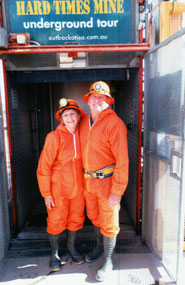
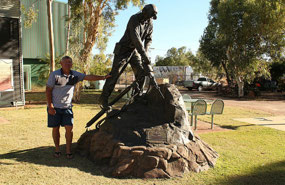
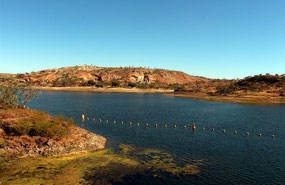
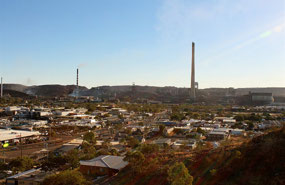
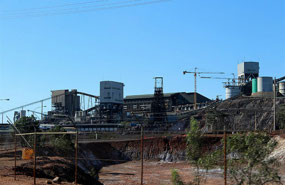
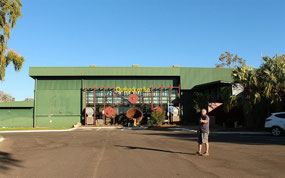
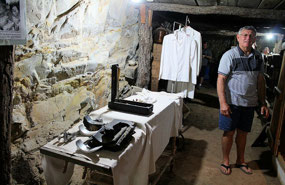
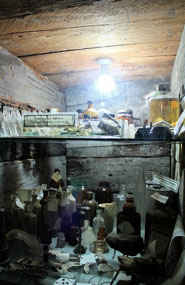

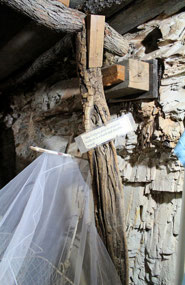
2025-05-22